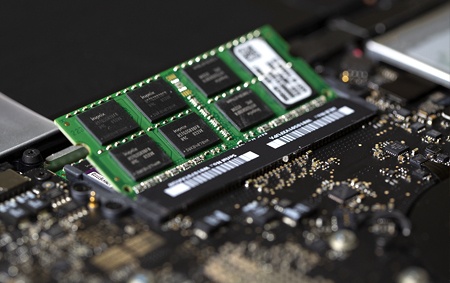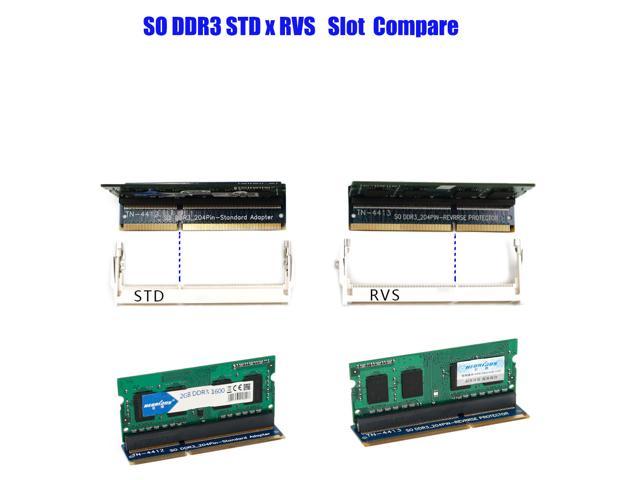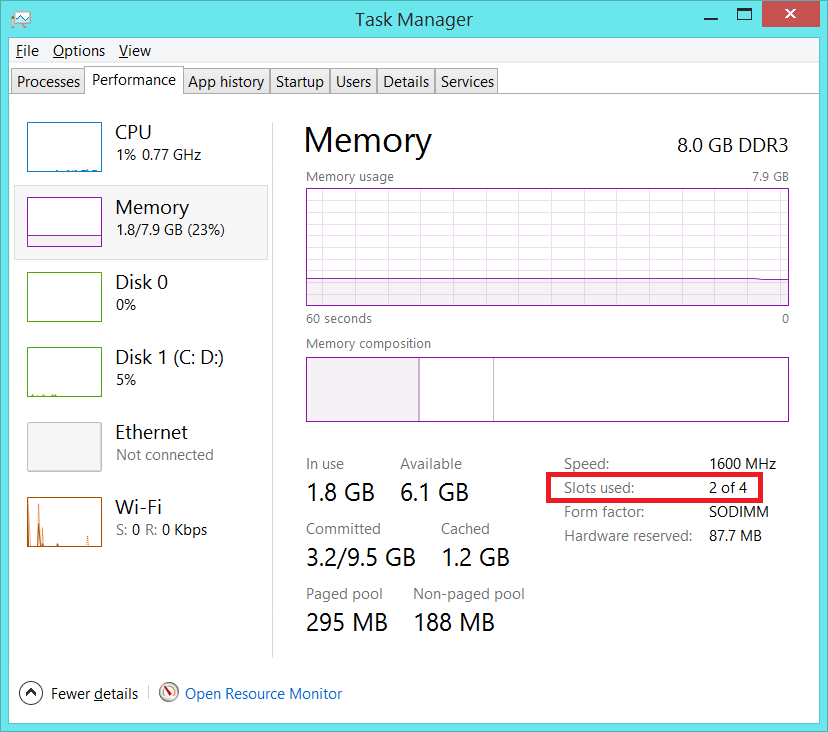고정 헤더 영역
상세 컨텐츠
본문

CORSAIR ValueSelect 8GB (2 x 4GB) 204-Pin DDR3 SO-DIMM DDR3 1333 (PC3 10600) Laptop Memory Model CMSO8GX3M2A1333C9. CAS Latency: 9 Timing: 9-9-9-24 Voltage: 1.50V Multi-channel Kit: Dual Channel Kit. A comparison between 200-pin DDR and DDR2 SDRAM SO-DIMMs, and a 204-pin DDR3 SO-DIMM module A SO-DIMM slot on a computer motherboard SO-DIMMs are often used in systems that have limited space, which include laptops, notebooks, small-footprint personal computers such as those based on Mini-ITX motherboards, high-end upgradable office printers.
Are DDR3 and DDR4 laptop memory (RAM) compatible? That’s a common question when it comes to memory upgrades. For instance, you bought a new laptop with DDR4 RAM and want to add more memory to it by inserting a DDR3 RAM module from your older laptop. You wonder if that’s possible. Unfortunately, that can’t be done. DDR3 and DDR4 laptop memory are not compatible / interchangeable.
First of all, a DDR3 laptop RAM module can’t physically fit into a DDR4 laptop RAM slot and vice versa. Notches on the connectors of memory sticks are on different places. The same applies to corresponding bumps in the RAM slots on notebook’s motherboards. Also, the number of pins doesn’t match. A DDR3 laptop memory module has 204 pins, whereas DDR4 has 260. Finally, DDR3 memory is a bit shorter than DDR4 – 2.66 versus 2.74 inches.
So, a DDR3 memory module won’t fit in a DDR4 slot…
And a DDR4 stick is incompatible with a DDR3 slot…
Besides the physical differences, DDR3 and DDR4 RAM differ in voltages. DDR3 uses a voltage of 1.5V (or 1.35V for DDR3L variant). DDR4 uses 1.2V. It is more power efficient and generally faster, but doesn’t noticeably improve overall performance nor battery life of notebooks.

Note: If you see “SODIMM” in specs of both DDR3 and DDR4 laptop memory, that doesn’t mean they are compatible. SODIMM only means they are small memory modules commonly used in laptops and some small form factor PCs, as opposed to physically much bigger DIMM memory used in traditional desktop computers. As a side note, DDR3 and DDR4 DIMMs aren’t compatible neither.
DDR3 vs DDR4
This article presents you a comparison between DDR3 and DDR4, highlighting the important differences between both RAMs. However, before delving into the difference between DDR3 and DDR4, let us see the specifications of both RAMS. As a matter of fact, DDR, which stands for Double Data Rate, is a specification used for RAM. DDR4 is the successor of DDR3 and hence consists of improvements in factors such as power consumption, size, speed and efficiency. DDR4, which was released this year, is still not much famous in the market but, in the next year, it will soon outstand DDR3. DDR4 RAMs consume less power than DDR3, but their speed is much higher. Also, the memory density allowed is higher in DDR4. The physical length of DDR3 and DDR4 are the same, but they are not backward compatible as the standard is different. Therefore, the notch in DDR3 and DDR4 are at different places and a DDR4 module will not fit into a DDR3 socket and vice versa.
What is DDR3?
DDR3, which stands for Double Data Rate Type 3, is a type of Dynamic Random Access Memory (DRAM) that came as the successor of DDR and DDR2. It was released to the market in 2007 and today almost all computers and laptops in the market uses DDR3 as the RAM. The voltage specification for DDR is 1.5 V and, therefore, it consumes very less power when compared to its predecessors. DDR3 standard allows chips up to capacity 8 GB. DDR3 RAM are available for different frequencies such as 800, 1066, 1333, 1600, 1866, 2133 MHz. A DDR3 RAM module used for personal computers has 240 pins and the length is 133.35 mm. The DDR3 modules used on laptops are called SO-DIMM and its length is much smaller with a length of 67.6 mm and less number of pins that is 204 pins. There is a special version of DDR3 RAMs called DDR3 low voltage standard, which uses just 1.35 V instead of 1.5 V and is used in some mobile devices to achieve better battery life.
What is DDR4?
DDR4 was introduced this year (2014) as the successor to DDR3. Still DDR4 is not much famous in the market because it was just released a few month ago and hence the motherboards in the market still supports only DDR3. However, after a few months , DDR4 will surely take over DDR3. DDR4 stands for Double Data Rate Type 4 and it has several advancements and improvements over DDR3. DDR4 supports higher memory densities up to 16 GB. The frequency in which DDR4 modules are available is higher than what DDR3 supports and the values available are 1600, 1866, 2133, 2400, 2667, 3200 MHz. The power consumption is further reduced as the voltage specification is 1.2 V. The lengths of DDR4 modules are same as the respective lengths of DDR3 module, but the number of pins is increased. The version used for PCs have 288 pins while the SO-DIMM modules used for laptops have 260 pins. A Low voltage standard DDR4 RAM, which would use about 1.05 V, will be available targeting for mobile devices that needs better power efficiency.
What is the difference between DDR3 and DDR4?
• DDR4 is the successor of DDR3.

• DDR3 was introduced back in 2007 while DDR4 was introduced in 2014.
• DDR3 supports memory densities only up to 8 GB, but DDR4 supports memory densities up to 16 GB.
• The speeds or the frequency of DDR4 RAMs are much higher than the frequency of DDR3 modules. This makes DDR4 much faster by providing better transfer rate.
• DDR3 works at a voltage of 1.5V while DDR4 works at a lesser voltage, which is 1.2V making it more power efficient.

• There is a special version of both DDR3 and DDR4 called low voltage standard, which uses lesser voltage hence lesser power. The low voltage standard of DDR3 uses 1.35V while it is 1.05V for DDR4.
• DDR3 modules have only 240 pins, but DDR4 modules have 288 pins.
• Both DDR3 and DDR4 have a smaller sized module known as SO-DIMM used for mobile devices such as laptops. SO-DIMM DDR3 has 204 pins while SO-DIMM DDR4 has 260 pins.
• DDR3 memory modules are not compatible with DDR4 slots and DDR4 modules are not compatible with DDR3 slots.
• The notch in the DDR3 and DDR4 is placed at different places so that they will not be mistakenly fixed to wrongs slots.
• DDR3 supports only 8 internal memory banks, but DDR4 supports 16 memory banks.
DDR3 | DDR4 | |
| Introduced in | 2007 | 2014 |
| Memory Density | Up to 8 GB | Up to 16 GB |
| Voltage | 1.5 V | 1.2 V |
| Voltage (Low voltage standard) | 1.35 V | 1.05 V |
| Supported Frequency (MHz) | 800, 1066, 1333, 1600, 1866, 2133 | 1600, 1866, 2133, 2400, 2667, 3200 |
| Internal Banks | 8 | 16 |
| No of Pins | 240 | 288 |
| No of Pins (SO-DIMM) | 204 | 260 |
Summary:
DDR4 vs DDR3
Ddr3 So Dimm 1333
DDR4 being the successor of DDR3 has various improvements. The speed or the frequency of the RAM modules have been much increased in DDR4 giving better transfer rate. A DDR4 module can have a size of 16 GB while this limited to 8 GB for DDR3. However, the power consumption of DDR4 is much less with a 1.2 V voltage used instead of 1.5 V. Therefore, it would be much power efficient providing better battery life for mobile devices. DDR4 memory modules are not compatible with DDR3 slots and vice versa hence the slot on the motherboard determines which type of RAM must be fixed. Currently, the board manufacturers use DDR3 slots but , in the next years, it will transform to DDR4.
Images Courtesy:
Ddr3 So Dimm Ddr3l 1600

1. DDR3 via Pixabay
Ddr3 So Dimms 204 Pin
2. Transcend_DDR400_TS64MLD64V4J By Solomon203 (Own work) [CC BY-SA 3.0 or GFDL], via Wikimedia Commons
Ddr3 Sodimm Slots Download
Related posts:






댓글 영역